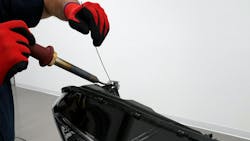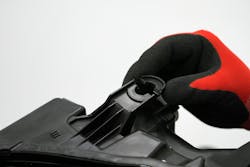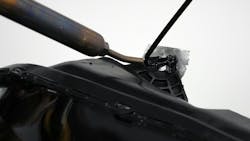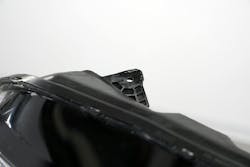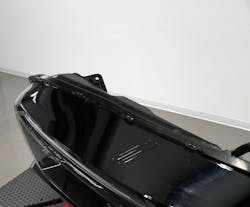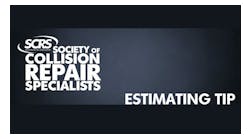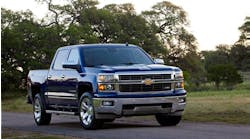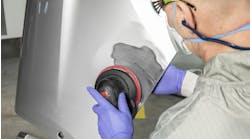Adapt to a changing environment by doing more plastic repairs
“We just replace it!” is a common refrain I hear when I’m in collision centers these days. “I don’t need more labor hours right now… I just need to move this backlog of work through the shop.” For good reason, especially since the pandemic, shop management has deemphasized the repair of damaged parts and accepted the higher cost of replacement parts as an expedient in response to the overall technician shortage and overwhelming workload.
However, there are recent signs that the backlog is receding and even that Gen Z workers are taking up the trades at a higher rate, so it may not be too long before the pendulum swings back and shop managers will have to persuade their technicians to dust off their hammers and dollies and start doing proper repairs again.
Repair vs. replace
Regardless of the external factors, there will always be situations where it will be faster and more cost-effective to replace a damaged part rather than repair it. But to maximize shop gross profit, the repair planner needs to constantly evaluate the pros and cons of repairing a particular part versus just replacing it. To make this decision, the repair planner needs to know the capabilities of the shop’s technicians to make quality repairs on the wide variety of substrates from which today’s vehicles are made.
From my own field of expertise in plastic repair, I see many opportunities for shops to do more repairs on the plastic parts that comprise a large number of the non-structural components in the front of a vehicle. Bumper covers are the first things that spring to mind, but with the incorporation of more ADAS sensors in and around the bumpers, and with OEM restrictions on their repair becoming more prevalent, emphasis on the repair of bumper covers has diminished in favor of a focus on the repair of headlight tabs.
Headlights are one of the most important safety components on a vehicle, and with all the advancements and innovations being used in modern headlight design they are also one of the most expensive components to replace. Over the past couple of decades, the cost of replacement headlights has dramatically increased. Headlights on high-end vehicles are already reaching costs of $3,000-$6,000 each, prices that are sure to spread to more common vehicles as they begin using the same technology. A shop that has the equipment and know-how to repair broken tabs on such headlights can reduce the cost and increase the profitability of the overall repair.
Evaluating the use case for plastic repairs
As the training manager for a manufacturer of plastic repair products, I am often in collision repair shops doing demonstrations and training. Recently I was at a shop to do a nitrogen plastic welding demonstration, and the area they had me set up was near the parts check-in department. I heard a part hit the floor and a few minutes later the body shop manager walked up with a brand-new headlight in one hand and a broken tab in the other hand. The person checking in and inspecting parts accidentally dropped the headlight and broke a tab off. The headlight had been on backorder, and they had been waiting on it for two weeks. This headlight was the only thing preventing the car from being delivered. The manager requested that I do the demonstration on the headlight and said that if I could restore the headlight to like-new condition, with proper strength and appearance, that they would look kindly on the purchase of our equipment. A few hours later, I had my equipment loaded in my van and the headlight was installed on the vehicle.
While this damage was caused in the shop, it’s not uncommon for headlights and other parts that are not in the direct impact zone, like airboxes and windshield washer reservoirs, to have minor damage. When this happens the part usually still functions as it should but has a few broken tabs or a cracked housing. Because headlights are a safety component, it is crucial to use the most effective repair method available to achieve a quality and safe repair. When it comes to the repair of meltable thermoplastic parts, like headlight tabs and housings, nitrogen plastic welding is the most effective method. Why? Because most headlight tabs are small and highly detailed. Fusion welding provides a strong repair even when the repair is confined to a small area, like on mounting holes or tabs. By contrast, two-part adhesives require application over a large area to achieve adequate strength and are thus not well-suited to making repairs on small, detailed areas.
Why nitrogen welding is an effective repair
Most headlight housings are made of polypropylene (PP) blended with a talc filler. You can most easily identify the type of plastic by looking for the ID symbols molded into the housing. You’ll often see a short list of ID symbols that also serve to identify the type of plastic used on the light’s other components, such as the lens (most commonly polycarbonate, or PC) and trim. Look for the symbol next to the word “HOUSING” or “HSG”. It will most often say “PP + T20”, or something similar. This means that the part is made primarily of polypropylene with 20% talc filler. There are certainly other components in the blend that are proprietary to the resin manufacturer, but this is what we need to know to choose the correct plastic welding rod to perform the repair.
Nitrogen plastic welding is a technique used to fuse plastic together. The strength comes from using welding filler rods that match the plastic from which the part is made. The nitrogen fusion welding process uses hot nitrogen gas to melt the welding rod and the substrate, allowing the materials to fuse together creating the highest quality repair possible. Eliminating oxygen from the weld zone prevents the plastics from burning and becoming weak and brittle. Using nitrogen gas to melt and fuse plastic also minimizes fumes which results in a cleaner work environment. Professional-quality machines will allow the technician to adjust both temperature and gas flow; the very thin plastics used on headlight tabs may overheat and distort if the gas flow or temperature isn’t set correctly for the type and thickness of the plastic being repaired.
Detailed repairs require some finesse from the technician
Welding small, detailed areas like headlight tabs requires a bit more finesse and a lighter touch from the technician than would be necessary on other parts, such as bumper covers. But with some training and practice, the skills are easily learned and can pay dividends on every vehicle that comes through the shop. The most time-consuming part of the repair is normally the cosmetic refinishing of the tab, especially if the damaged tab is visible by the customer when the hood is opened. In fact, the ability to restore the cosmetic appearance is most often the deciding factor on whether to perform a repair or not. Headlight repair specialists often have small tools used by hobbyists to build plastic models to aid in the refinishing process.
Darwin didn’t say “only the strong survive.” He said “the one that’s most adaptable to change” will survive. If you want your shop to continue to thrive in a changing environment, dust off your hammers and dollies and get ready to do more repairs. The era of throwing parts at the car and expecting to be paid in full may soon be behind us.
